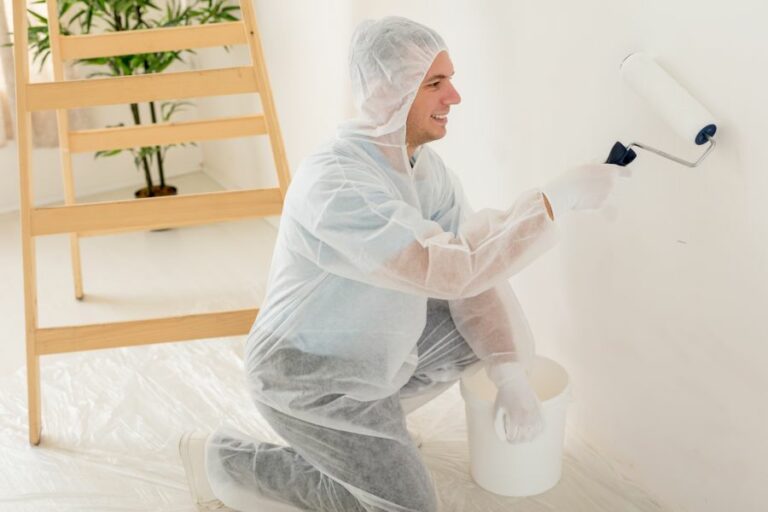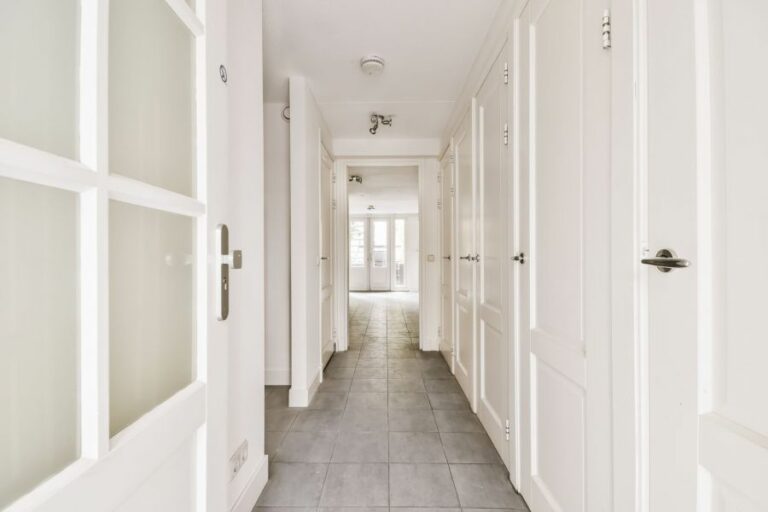Types Of Indoor Painting Primer, 25 Things You Should Know
Choosing the right primer can make all the difference in achieving a flawless and long-lasting paint job indoors. Luckily, I’m here to help you navigate the various indoor painting primers available, ensuring you get the perfect base for your paint.
Types of indoor painting primer:
Indoor painting primers include oil-based, latex-based, shellac-based, and specialty primers such as bonding, drywall, and vapor-barrier primers. Oil-based primers provide excellent adhesion and durability, while latex-based ones offer quick drying times and lower VOCs. Shellac-based primers excel at stain blocking, and specialty primers target specific scenarios. Choosing the right primer depends on the surface, staining, odors, and personal preferences.

Are you preparing for an indoor painting project? Discover the various types of primers available, their unique benefits, and how to choose the best one for your specific needs. Read on and become a primer pro!
Contents
- 1 Indoor Painting Primer Varieties
- 2 Selecting the Right Primer for Interior Walls
- 3 Guide to Choosing Interior Paint Primers
- 4 Different Paint Primer Options Explained
- 5 Top-Rated Paint Primers for Home Interiors
Indoor Painting Primer Varieties
Indoor painting projects often require the use of a primer to prepare the surface for the finish paint. Primers serve several purposes, including promoting adhesion, increasing durability, and providing a uniform base for the topcoat.
• Oil-Based Primers
Oil-based primers have been used for many years and offer several advantages. They tend to penetrate the surface more in-depth, providing excellent adhesion and long-lasting substrate protection.
– Benefits of Oil-Based Primers
- Excellent adhesion to a wide range of surfaces
- Seal surface stains and knots effectively
- Suitable for both smooth and textured surfaces
- Durable and resistant to cracking
– Drawbacks of Oil-Based Primers
- Longer drying time compared to other primers
- Strong odors and VOCs, which may not be suitable for those with respiratory issues
- Requires the use of paint thinner or mineral spirits for clean-up.
I recommend oil-based primers for projects involving wood, such as cabinetry or trim, or areas with heavy staining, such as water damage or smoke.
• Latex-Based Primers
Also known as water-based primers, latex-based primers have become incredibly popular due to their ease of use, faster drying times, and lower VOCs. They are an excellent choice for most indoor painting projects.
– Benefits of Latex-Based Primers
- Quick-drying, usually within an hour
- Easy clean-up with soap and water
- Low VOCs and milder odor compared to oil-based primers
- Great adhesion to a variety of surfaces
– Drawbacks of Latex-Based Primers
- May not be as effective at sealing stains as oil-based primers
- Can sometimes cause the topcoat to appear uneven on highly porous surfaces.
Latex-based primers are suitable for most surfaces, including drywall, plaster, and previously painted surfaces. However, a specialized primer may be necessary for surfaces with heavy stains or strong odors.
• Shellac-Based Primers
Shellac-based primers are known for their exceptional stain-blocking capabilities. They are derived from a resin secreted by the lac bug and have been used for centuries in various applications.
– Benefits of Shellac-Based Primers
- Unparalleled stain-blocking capabilities, including ink, smoke, and tannin stains
- Fast-drying, often in under an hour
- Can be used on various surfaces, including wood, plaster, and metal
– Drawbacks of Shellac-Based Primers
- Strong odor and VOCs, similar to that of oil-based primers
- Requires denatured alcohol for clean-up
- More expensive than other primer options
Shellac-based primers are perfect for projects requiring robust stain-blocking capabilities or sealing in strong odors. They can be used on various surfaces but are most commonly used for restoration projects where smoke or water damage has occurred.
• Specialty Primers
In addition to the general-use primers mentioned above, there are several specialty primers tailored to specific situations or surfaces.
– Bonding Primers
These primers are designed to promote adhesion on challenging surfaces like glossy paint or tile. Bonding primers can be oil, latex, or shellac-based but contain additives that enhance their ability to adhere to slick surfaces.
– Drywall Primers
Specifically formulated to adhere well and create a uniform surface on new drywall or over joint compound, drywall primers are usually latex-based and can help save on finish paint costs.
– Vapor-Barrier Primers
Used in high moisture areas, such as bathrooms or laundry rooms, these primers help reduce the transmission of moisture through the walls, preventing mold and mildew growth.
• Choosing the Right Primer
To determine the best primer for your project, consider the surface you’re about to paint, any staining or odor issues, and your personal preferences regarding drying times and VOCs. When in doubt, consult with a professional or visit your local paint store for guidance.
In conclusion, understanding the types of indoor painting primers and their specific advantages can help you select the best primer for your project. With the right primer, you can ensure a beautiful, long-lasting finish for your indoor painting project.
Selecting the Right Primer for Interior Walls
Selecting the appropriate primer for interior walls is a crucial step in achieving a professional-looking paint job. Primer serves as the foundation for your paint, ensuring optimal adhesion and a smooth finish.
Moreover, it enhances the paint’s durability, helps hide imperfections, and provides additional protection to the surface.
• Types of Interior Wall Primers
– Latex-Based Primers
Latex-based primers are water-based and among the most popular choices for interior walls. They are user-friendly, quick-drying, and easy to clean up with soap and water. Latex primers are typically compatible with a wide range of surfaces, including drywall, plaster, and wood.
Pros:
- Easy to apply and clean
- Low odor
- Fast-drying
- Ideal for drywall and other porous surfaces
Cons:
- Not suitable for sealing stains
- May cause wood grain to swell
– Oil-Based Primers
Oil-based primers are an excellent option for sealing tough stains, such as water damage, smoke, and crayon marks. They also provide superior adhesion, making them ideal for glossy or slick surfaces. Oil-based primers are known for their excellent durability and penetration, making them suitable for hard-to-paint materials like knots and tannin-rich woods.
Pros:
- High stain-blocking capabilities
- Excellent adhesion
- Resistant to bleed-through from wood tannins
Cons:
- Longer drying time
- Strong odor
- Requires mineral spirits for cleanup
– Shellac-Based Primers
Shellac-based primers are made from a natural resin and provide exceptional stain-blocking and odor elimination. They form an impenetrable barrier over the surface, making them the ultimate choice for severe stains and smoke damage.
Though less commonly used than latex or oil-based primers, shellac primers offer some unique advantages.
Pros:
- Unparalleled stain blocking
- Fast-drying
- Seals in odors and smoke
- Bonds well to glossy surfaces
Cons:
- High odor during application
- Limited compatibility with some topcoats
- Requires denatured alcohol for cleanup
• Factors to Consider When Selecting an Interior Wall Primer
– Surface Type
Different types of surfaces require specific primers to ensure optimal adhesion and coverage. Latex-based primers are generally the preferred choice for drywall, while oil-based primers excel on slick surfaces or stained wood.
If you’re dealing with severe stains or odors, a shellac-based primer may be necessary.
– Stain Blocking and Sealing
Evaluate the need for stain blocking and sealing when choosing a primer. If you’re covering up water stains or smoke damage, opt for an oil-based or shellac-based primer to prevent bleed-through. For regular interior walls with minimal staining, a quality latex primer should suffice.
– Drying Time and Odor
Consider drying time and odor in your primer selection. If you’re in a rush or sensitive to strong fumes, latex primers offer a quick-drying, low-odor solution. While oil and shellac-based primers have longer drying times and stronger odors, they might be necessary for specific tasks, such as sealing severe stains.
– Compatibility with Topcoats
Ensure that your chosen primer is compatible with your desired topcoat. Latex-based primers typically work well with both water and oil-based paints, while oil and shellac-based primers are more limited in their compatibility. Always check the manufacturer’s guidelines to avoid potential adhesion problems.
• Professional Recommendations
I recommend using a high-quality latex-based primer for general-purpose interior wall priming. It offers a good balance of versatility, ease of use, and overall performance. Brands like Benjamin Moore’s Fresh Start and Zinsser’s Bulls Eye 1-2-3 are time-tested and highly regarded in the industry.
Consider an oil-based primer like Zinsser’s Cover Stain or Kilz’s Original for surfaces requiring superior adhesion or stain-blocking capabilities. Should you be faced with the most severe staining and odor issues, a shellac-based primer like Zinsser’s B-I-N will provide the ultimate solution.
• Conclusion
In summary, the right primer for your interior walls depends on the surface type, stain-blocking requirements, and desired drying time and odor levels. By selecting the appropriate primer, you’ll ensure a smooth, professional-looking paint job that lasts for years to come.
Remember to consult the manufacturer’s guidelines for primer and topcoat compatibility and seek advice from paint professionals if unsure about your specific situation. Happy painting!
Type of Primer | Description |
|---|---|
Latex Primer | Water-based and fast-drying, latex primer is the most versatile and commonly used primer for interior walls. It works well on most surfaces, including drywall, plaster, and wood. |
Oil-Based Primer | Though slower to dry, oil-based primer provides excellent adhesion and stain-blocking properties. It is suitable for interior walls with heavy stains, water damage, or smoke damage. However, it may have strong odors and requires paint thinner for cleanup. |
Shellac Primer | Shellac primer is highly effective at sealing stains, odors, and providing excellent adhesion. It works well on interior walls with severe issues like mold, mildew, or heavy water damage. It dries quickly but has a strong smell and requires denatured alcohol for cleanup. |
Guide to Choosing Interior Paint Primers
A primer is essential to any painting project, primarily when dealing with interior surfaces. The right primer can make all the difference in achieving professional-looking results on any paint job.
• Understanding the Purpose of a Primer
Before we dive into the specifics of selecting a primer, it’s essential to understand its purpose. A primer serves as an intermediary layer between the surface you are painting and the top coat of paint. It helps to:
- Improve the adhesion of paint onto the surface
- Create a uniform base for the paint to adhere to and prevent paint absorption
- Enhance the durability of the paint and protect the substrate.
- Block stains, tannins, and odors from seeping through the paint.
With these benefits in mind, let’s discuss the factors you need to consider when choosing an interior paint primer.
• Assessing the Surface to be Painted
When it comes to interior paint primers, understanding the type of surface you’ll be working with is crucial. Common interior surfaces include drywall, plaster, previously painted surfaces, and bare wood.
For new or uncoated drywall, a high-quality drywall primer is recommended. These primers are specifically designed to seal the porous surface of new drywall and provide an excellent base for your paint.
A primer with excellent adhesion properties is vital if you’re working with plaster surfaces. Oil-based primers tend to work well on plaster walls, though some exceptional water-based primers perform just as well.
For previously painted surfaces, examining the current paint’s condition is crucial. You can use a high-quality latex primer if the existing paint is in good shape. However, if the paint is peeling, chipping, or has water stains, you may need to use a tougher primer with stain-blocking capabilities.
Primers that can effectively seal the porous surface and block tannins from resins or knots are necessary when painting bare wood. Shellac-based primers are traditionally recommended for this purpose, though some high-quality oil-based options are available.
• Odor and VOC Levels
Traditional oil-based primers tend to have a strong odor and high VOC (Volatile Organic Compound) levels, which can be harmful to the environment and human health.
You may want to look for low VOC and low odor primer options, especially if you or someone in your household is sensitive to strong odors or suffers from breathing problems. Water-based and latex primers generally have lower VOC levels and produce fewer odors compared to oil-based primers.
• Drying Time
Drying time is another factor to consider when choosing an interior paint primer. Oil-based primers generally take longer to dry than water-based or latex primers. If you need to complete your painting project within a tight deadline, you may want to opt for a primer with quick drying time.
• Color Considerations
The primer’s color will also impact the final appearance of your paint job. A tinted primer can provide a uniform base for your paint, enabling you to achieve the desired color more easily. This is particularly useful when applying a light paint color over a darker surface or vice versa.
Most paint stores can coordinate your primer’s color with your chosen paint color, so don’t hesitate to ask for a tinted primer.
• Budget
Lastly, consider your budget when selecting an interior paint primer. While it’s essential to invest in a high-quality primer, a range of price options are available to suit different budgets. Balancing the cost with the quality and desired performance of the primer is essential.
• Expert Recommendations
For a reliable all-purpose primer, I recommend the Zinsser 123 water-based primer. This primer is known for its excellent adhesion, versatility, and low-odor properties, making it suitable for various interior surfaces.
I recommend the KILZ Original oil-based primer for tough stains and odor blocking. This high-performance primer blocks stains and odors and provides an even base for paint, making it ideal for problematic surfaces.
In conclusion, choosing the right interior paint primer is crucial to achieving professional-looking results. To make the best decision, consider factors such as surface type, odor and VOC levels, drying time, color, and budget.
By considering these factors, you’ll be well on your way to a beautiful and long-lasting paint job. For further guidance, you can refer to the EPA’s guidelines on paint and primer selection.
Different Paint Primer Options Explained
Paint primer is an essential part of any painting project. It creates a smooth, even surface for the paint to adhere to and helps protect the underlying material while providing a professional finish.
• Oil-Based Primers
Oil-based primers are a popular option due to their excellent adhesion and durability. They are suitable for a wide range of surfaces, including wood, metal, and masonry. These primers are the go-to choice for many professionals because they block stains and seal porous surfaces.
Recommendation: When working with wood, oil-based primers are an excellent option, as they can help prevent tannin bleed from certain wood species, such as cedar or redwood.
– Benefits of Oil-Based Primers
- Excellent adhesion to a variety of surfaces
- High durability and resistance to damage
- Ability to block and seal stains
- Excellent for preventing tannin bleed
– Drawbacks of Oil-Based Primers
- Longer drying time
- Strong odors and higher VOCs (volatile organic compounds)
- Requires mineral spirits for cleanup
- Not compatible with all paint types
• Latex-Based Primers
Latex-based primers are water-based and offer a more environmentally friendly option. They are best suited for porous surfaces like drywall and bare wood. These primers dry quickly and have lower odor than oil-based primers. They also offer easier clean-up, as they only require water and soap.
Recommendation: When painting drywall or fresh wood, latex-based primers are ideal for a smooth finish and quick drying time.
– Benefits of Latex-Based Primers
- Quick drying time
- Lower odor and VOC content
- Easy to clean up with water and soap
- Good adhesion to porous surfaces
– Drawbacks of Latex-Based Primers
- Less effective at sealing stains compared to oil-based primers
- May not adhere as well to non-porous surfaces
- Shorter lifespan on exterior surfaces
• Shellac-Based Primers
Shellac-based primers are a less common but highly effective option for specific use cases. They are known for their ability to seal stains, including water damage, smoke, and grease. They can be used on various surfaces, such as wood, metal, plaster, and even plastic.
Recommendation: When dealing with a surface that has severe stains or damage, shellac primers provide an effective barrier to prevent bleed-through to the top layer of paint.
– Benefits of Shellac-Based Primers
- Exceptional stain-blocking ability
- Adheres well to a variety of surfaces
- Fast drying time
- Resistant to mold and mildew
– Drawbacks of Shellac-Based Primers
- Strong odor and high VOC content
- Requires denatured alcohol for clean up
- Not as widely available as other primer types
• Specialty Primers
A variety of specialty primers are available to address unique or challenging situations that may arise during a painting project.
– Bonding Primer
Bonding primers are designed to help paint adhere to hard, glossy surfaces such as tile, glass, or high-gloss paint. These primers create a bond between the surface and the paint, ensuring a proper and long-lasting finish.
Recommendation: Use a bonding primer when painting over glossy or challenging surfaces to improve adhesion and paint performance.
– Rust-Inhibiting Primer
Rust-inhibiting primers are specifically formulated for use on metal surfaces that may be prone to corrosion or rust. These primers contain anti-corrosive additives that help prevent the formation of rust on the metal surface, extending the life of your paint job.
Recommendation: When painting metal surfaces, especially those exposed to moisture or harsh conditions, a rust-inhibiting primer can help protect and extend the life of your paint job.
– Mold and Mildew Resistant Primer
Mold and mildew-resistant primers are designed for use in areas with high humidity, moisture exposure, or known mold issues. These primers contain mold and mildew inhibitors that help prevent the growth of these fungi on your paint surface.
Recommendation: In rooms with high humidity or previous mold and mildew issues, using a mold and mildew-resistant primer can help protect the health and appearance of your paint job.
For further information on paint primers and choosing the best type of primer for your project, the Environmental Protection Agency offers resources on paint types, VOC content, and environmentally friendly choices.
In conclusion, understanding the various types of paint primer available allows you to make the best choice for your specific painting project.
Each type of primer has unique benefits and drawbacks, from oil-based primers that offer excellent durability to latex-based primers for a quick-drying, low-odor option. By carefully considering the surface you are painting and the desired result, you can ensure a smooth, professional finish that will last.
| Type of Paint Primer |
|---|
| Oil-based primer |
| Latex primer |
| Shellac primer |
| Water-based primer |
| Alkyd primer |
| Enamel primer |
| Epoxy primer |
| Polyurethane primer |
Top-Rated Paint Primers for Home Interiors
A well-painted house not only enhances its appearance but also increases its value. However, for paint to last longer and provide the best finish, a crucial step is often overlooked – applying a high-quality primer.
• Importance of a Good Quality Primer
Primers serve as the foundation for paint, creating a stable surface for the paint to adhere to. They provide multiple benefits, such as:
- Improving paint adhesion
- Masking stains
- Enhancing the durability of the paint job
- Providing additional protection to the surface being painted
- Reducing the number of coats required, as they help in covering imperfections
Choosing the best paint primer is essential for achieving long-lasting, professional-looking results for your house.
• Types of Paint Primers
There are various types of paint primers available in the market that cater to different surfaces and finishes. Here are four of the most common types:
– Oil-Based Primers
Oil-based primers, also known as alkyd primers, provide excellent adhesion and stain-blocking capabilities. They’re ideal for use on:
- Wood, including both interior and exterior sections and raw wood surfaces
- Bare metal, especially rusty surfaces
- Interior floors, as they offer abrasion-resistant properties
However, oil-based primers can have longer drying times, a stronger odor, and require mineral spirits for clean-up.
– Latex-Based Primers
Latex-based primers, also known as water-based primers, offer easy clean-up, fast drying, and low odor. Suitable for the following surfaces:
- Wood, metal, and masonry surfaces
- Previously painted surfaces
- Drywalls and plaster
- Galvanized metal
These primers might not work as effectively on heavily stained areas or on extremely slick surfaces, as their adhesion may not be as strong as oil-based primers.
– Shellac-Based Primers
Shellac-based primers are known for their unparalleled stain-blocking and odor-sealing capabilities. They’re best for:
- Stain-blocking, especially severe water, smoke, and nicotine stains
- Sealing in unpleasant odors
- Spot-priming on wood or plaster
Shellac-based primers have a strong alcohol-like odor and require denatured alcohol for clean-up.
– Bonding Primers
Bonding primers are specifically designed to adhere to tough-to-paint surfaces, such as glossy or slick surfaces, that conventional primers may struggle with. They can be oil, latex, or shellac-based. Use bonding primers for:
- Tiles, glazed block, and plastics
- Laminate, glossy paint, or varnish
Bonding primers are often used as an alternative to sanding or deglossing a surface.
• Recommendations for the Best Paint Primer for House Use
Based on the different types of primers and their specific uses, here are some recommendations for the best paint primer for a house:
- Zinsser Bulls Eye 1-2-3: A water-based latex primer that offers excellent adhesion, stain blocking, and versatility. It works well on both interior and exterior surfaces. For more information on this product, visit the Zinsser website.
- KILZ Original Multi-Surface Stain Blocking Primer: An oil-based primer that provides a reliable wood, drywall, and plaster base. It also has strong stain-blocking and odor-sealing capabilities. Learn more about KILZ primers at the official website.
- Zinsser B-I-N Shellac-Base Primer is an exceptional shellac-based primer that blocks heavy stains and sealing odors. For more details, refer to the Zinsser website.
- XIM UMA Advanced Technology Bonding Primer – a water-based bonding primer that adheres well to challenging surfaces, such as glossy or smooth materials. Visit the XIM website for further information.
Always consider the specific requirements of your project and the surfaces you will be painting when choosing a primer. Consult with a professional painter or local paint store expert for personalized advice.
• Conclusion
Selecting the best paint primer for your house is essential for a durable, high-quality finish. By understanding the various types of primers and their specific uses, you can choose the ideal primer to achieve a professional and long-lasting paint job for your home.
Consult with experts and refer to the recommendations provided in this article to ensure the best possible results for your painting project.
Rank | Product Name | Description |
|---|---|---|
1 | KILZ 2 Multi-Surface Stain Blocking Primer | A water-based primer suitable for both interior and exterior surfaces, providing excellent adhesion and preventing mildew growth |
2 | Zinsser Bulls Eye 1-2-3 Water-Based Primer | Formulated to bond with various surfaces such as wood, concrete, and metal; fast-drying and easy to clean |
3 | Rust-Oleum Zinsser Cover Stain Oil-Based Primer | An oil-based primer with powerful stain-blocking properties, it works well on water stains, smoke damage, and wood tannin |
4 | KILZ Original Multi-Surface Stain Blocking Primer | An oil-based formula ideal for blocking tough stains and odors on furniture, walls, and floors. |
5 | Zinsser Smart Prime Water-Based Interior/Exterior Primer | Bonds well to multiple surfaces, providing excellent adhesion and even finish for paint jobs |







